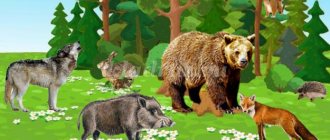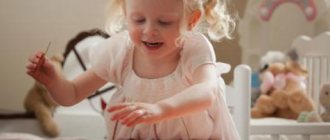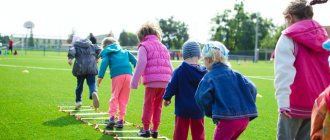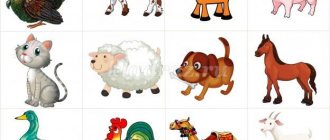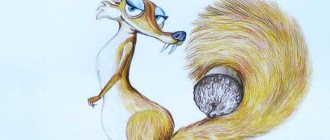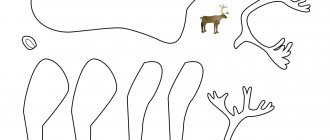Domestic and wild animals. Lesson notes for the first junior group using ICT
SYNOPSIS of direct educational activities in the junior group on the topic: “Domestic animals and their cubs” “Cognition”
— Introduce children to pets.
teach to distinguish between animals and their young. “Social-communication”
- practice sound pronunciation loudly and quietly;
develop the ability to answer questions; activate your vocabulary with words: “foal”, “puppy”, “kitten”, “calf”. “Physical development” -
Develop hand coordination, fine motor skills;
develop motor activity of children. ICT tools:
presentation, projector, screen.
Materials and equipment:
Large toy car - truck; toys – horse, dog, cat, cow; kitten, puppy, foal. Pictures from the series “Animals and their cubs” - “Cat with a kitten”, “Dog with a puppy”, “Horse with a foal”, “Cow with a calf”.
The logic of direct educational activities:
Slide 1
“Pets”
| Educator: - Children, look - “Who is visiting us?” Conversation about pets Slide 2. " Cow"
|
Educator: - Guys, I have more pictures, let's look at them. Slide5
“Cat with a kitten” Educator: - What animals are shown in each picture?
Children: - (recognize and name them) Educator: - Guys, who is drawn next to the cat? Educator: - Correct! Kitty. This is her cub, draws the children’s attention to the fact that the cat is big, the kitten is small. The cat is big, meows loudly, drawn out: “Meow-meow-meow,” and what about the kitten? Children: - (reproduce the meowing of a cat and a kitten) The cat says to the kitten, Grow up a little more, but the baby can’t wait to play cat and mouse with her. Slide 6
“Dog with a puppy” Educator: - Look, who’s in this picture?
Children: Teacher: - That's right! Dog! And who is next to her? This is her cub - a puppy. Educator: - Who is this? Repeat: Dog and puppy Happy birthday, puppies, mom kisses everyone on the cheeks, And the puppies raise their tails, Answer her: “Woof! Woof! Teacher: - draws the children’s attention to the fact that the dog is big and the puppies are small, and the dog barks loudly: “Woof-Woof-Woof, what about the puppies? Children: - (reproduce the singing of the dog and puppies - in chorus and individually). Slide 7
“Horse with a foal” Educator: - Look, who is in this picture?
Educator: - Correct! Horse! And who is next to her? This is her baby foal. Educator: - Who is this? Repeat: Horse with foal. The teacher draws the children’s attention to the fact that the horse is big, the foal is small, and the horse shouts loudly: “Igo-go!”, but what about the foal? Children: - (reproduce the singing of the horse and foal in chorus and individually). The teacher brings into the group room a large toy car, in the back of which there are toys: a cat, a horse, a dog, a cow, and their cubs). Children look at toys and play with them. Educator: - Now let's place the kitten, puppy and foal with their mothers. Educator: - Who loves a kitten dearly? Who will give you milk? Well, of course mom! Children: - (children's choral answers) Educator: - Who will give the puppy some love? Well, of course mom! Children: - (children's choral answers) Educator: - Who will protect the foal from the wind? Will he scold and forgive? Well, of course mom! Children: - (children's choral responses). Educator: - And now we have a game, I will be a mother cat, and you will be my little kittens. Children: - (play, run) (The cat called them, the kittens run up to her) - While you and I were playing, all the mothers of pets lost their babies, the mothers are worried and ask us to help them. There is a Did/Game “Find the Cub” - Guys, do you like to play? (Children's answers) -And now the animals offer you to play the game hide and seek. (children look carefully and remember everyone they see. Then the children turn away, and the teacher removes one animal figurine. -Which of the animals hid from you? (children’s answers). Slide 8
“Pets and their cubs.”
Reflection: Educator: Guys, we played and talked. Now let's remember what we talked about today. - Who came to visit us today? -What do these animals eat? -Where do they live?
Summary of educational activities for speech development in the nursery group “Our Pets”.
Summary of GCD for speech development
in the nursery group “Our Pets”.
Objectives: expand children's knowledge about domestic animals; enrich your vocabulary, name animals and actions (the concept of “pet” is in the passive dictionary); continue to learn how to construct sentences and answer questions; encourage them to be active and
independence.
Material: bag with animal toys (cow, horse, dog, cat, goat, pig).
Progress of the lesson
The teacher calls the children over and asks: “Look, guys, what is this magic bag we have here, who is hiding in it?” A voice is heard: “We! We!" "Who is this?"
He looks into the bag and asks in surprise: “Who is scratching here? What do you guys think?”
Cat
On the balcony outside the window there is a black and white spot. Now curled up, now sideways, Watching the sun with his eye. Ears, eyes, tail and paws, This is a Tsap-scratch cat. — A cat’s child is called a kitten. The kitten says: “Meow-meow.” Say it like a kitten says.
The teacher takes out a toy and asks to name who it is. Cow
A cow has horns and hooves on its legs. She chews grass and gives milk to the children. — A cow’s child is called a calf. The calf says: "Moo-oo." Say it like the calf says.
Another voice is heard: “Igo-go!” "Who is this?" Horse
The horse has a long mane and has a cheerful and playful disposition. She will eat the hay now, and give us a ride. - A horse's child is called a foal. The foal says: “i-go-go.” Say it like a foal says.
The teacher takes out a horse and invites the child to take a toy, asks questions: “Who saw the horse? Who was riding a horse? What was she like? Encourages children's initiative and their desire to answer independently.
The teacher continues: “Who else lives next to us? Woof! Woof! Woof! Who
This? Dog Bug. What does she ask the guys? A bone. Dog
The dog gnaws bones, bites evil people too - so that a thief does not get in, guards both the house and the yard. -A dog’s baby is called a puppy. The puppy says: “woof-woof.” Say it like a puppy says.
The teacher looks into the bag: “Who else do we have here?” Goat
The jumping goat, mischievous, butting, likes to sneak, eat cabbage from the garden. — A goat’s child is called a kid. He says: “Me-e-e.” Say it like the little goat says.
The teacher continues: “Who is this left in our bag?” Pig
The dirty pigs have bristles on their backs, a snout on their faces, and a thin hooked tail on their backs. - A pig's child is called a piglet. The pig says: “oink-oink.” Say it like the pig says.
These guys are all pets.”
At the end of the lesson, you can offer to play with animal toys:
build them houses, feed them, while asking questions:
“What he loves”, “What we will feed.” The teacher supports and encourages
children's initiative.

